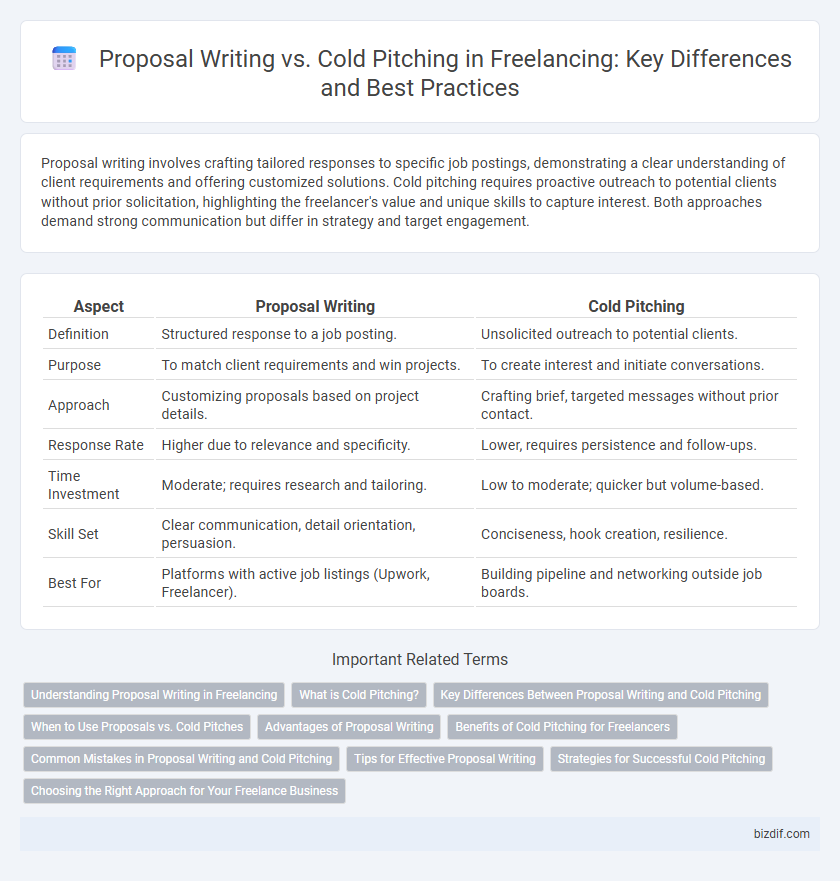Proposal writing involves crafting tailored responses to specific job postings, demonstrating a clear understanding of client requirements and offering customized solutions. Cold pitching requires proactive outreach to potential clients without prior solicitation, highlighting the freelancer's value and unique skills to capture interest. Both approaches demand strong communication but differ in strategy and target engagement.
Table of Comparison
| Aspect | Proposal Writing | Cold Pitching |
|---|---|---|
| Definition | Structured response to a job posting. | Unsolicited outreach to potential clients. |
| Purpose | To match client requirements and win projects. | To create interest and initiate conversations. |
| Approach | Customizing proposals based on project details. | Crafting brief, targeted messages without prior contact. |
| Response Rate | Higher due to relevance and specificity. | Lower, requires persistence and follow-ups. |
| Time Investment | Moderate; requires research and tailoring. | Low to moderate; quicker but volume-based. |
| Skill Set | Clear communication, detail orientation, persuasion. | Conciseness, hook creation, resilience. |
| Best For | Platforms with active job listings (Upwork, Freelancer). | Building pipeline and networking outside job boards. |
Understanding Proposal Writing in Freelancing
Proposal writing in freelancing involves creating detailed, customized documents that outline how a freelancer plans to meet a client's project needs, demonstrating clear understanding and value. It requires thorough research on client requirements, precise articulation of skills, deliverables, timelines, and pricing to make a persuasive case. Effective proposal writing increases the chance of securing projects by building trust and showcasing professionalism compared to generic cold pitching.
What is Cold Pitching?
Cold pitching in freelancing involves directly reaching out to potential clients without prior interaction or a formal job posting, aiming to present your skills and services proactively. This approach requires crafting personalized messages that highlight your expertise and address the client's possible needs to capture their interest. Effective cold pitching can open new opportunities by tapping into clients who may not have advertised projects yet.
Key Differences Between Proposal Writing and Cold Pitching
Proposal writing involves a structured, detailed document tailored to a specific project or client, highlighting skills, timelines, and budget estimates to address their needs directly. Cold pitching is an unsolicited outreach method where freelancers introduce themselves and their services without a prior request, aiming to create interest and start a conversation. Proposal writing is reactive and project-specific, whereas cold pitching is proactive and broader in approach.
When to Use Proposals vs. Cold Pitches
Proposals are most effective when responding to detailed client requests or defined project scopes, allowing freelancers to tailor solutions and showcase expertise directly related to client needs. Cold pitching suits situations where freelancers proactively target potential clients without prior outreach, emphasizing concise value propositions and unique skills to spark interest. Understanding the client's readiness and project clarity guides freelancers in choosing between comprehensive proposals and strategic cold pitches for optimal engagement.
Advantages of Proposal Writing
Proposal writing offers tailored and detailed communication that directly addresses a client's specific project requirements, increasing the likelihood of positive responses. Crafting personalized proposals demonstrates professionalism and a clear understanding of client needs, distinguishing freelancers from competitors who use generic outreach methods. This targeted approach enhances credibility and establishes a foundation for stronger client relationships and higher conversion rates in freelance projects.
Benefits of Cold Pitching for Freelancers
Cold pitching offers freelancers the advantage of directly targeting potential clients outside typical job listings, expanding their reach beyond crowded platforms. This proactive approach allows freelancers to customize proposals specifically to client needs, increasing the chances of securing exclusive projects. Cold pitching also helps build long-term professional relationships by demonstrating initiative and commitment to prospective clients.
Common Mistakes in Proposal Writing and Cold Pitching
Common mistakes in proposal writing include lack of personalization, vague project understanding, and failure to clearly outline value propositions, causing low client engagement. In cold pitching, frequent errors involve generic messaging, ignoring client needs, and weak follow-up strategies that reduce response rates. Both approaches require targeted communication and thorough research to increase success in freelancing opportunities.
Tips for Effective Proposal Writing
Crafting a clear, concise proposal tailored to the client's specific needs significantly increases the chances of winning freelance projects. Highlight relevant skills, demonstrate understanding of the project scope, and include measurable outcomes to establish credibility. Personalizing each proposal by addressing the client's pain points and suggesting tailored solutions can set you apart from generic cold pitches.
Strategies for Successful Cold Pitching
Successful cold pitching strategies include thorough research on potential clients to tailor proposals that address their specific needs, increasing response rates. Crafting concise, value-driven messages with clear calls to action enhances the likelihood of engagement in freelancing projects. Leveraging professional platforms like LinkedIn and Upwork to identify opportunities and follow up persistently helps build credibility and secure contracts.
Choosing the Right Approach for Your Freelance Business
Proposal writing involves crafting tailored, detailed responses to specific client requests, showcasing your skills and project understanding to increase the likelihood of winning contracts. Cold pitching requires proactive outreach to potential clients without prior solicitation, demanding concise and compelling messaging to capture attention. Selecting the right approach depends on your niche, industry trends, client preferences, and your ability to customize communication effectively for maximum engagement and conversion.
Proposal Writing vs Cold Pitching Infographic

 bizdif.com
bizdif.com